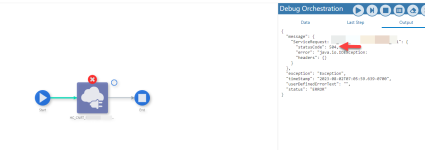One thing I've noticed in the response below... The API produce http status = 400. Notice the time stamps in the this response. They seem to be appended with the http status -0400. Could this really be true? If so, what a hack this is Oracle. If this is how Oracle implemented this, shame, shame. I wonder if a successful response also has the timestamps appended with the http status... I"m looking into it
{
"message": "Orchestration has no output",
"timeStamp": "2023-08-03T08:54:33.230-0400",
"continuedOnError": [
{
"step": "55CN_SAPeCommerceOrder_Connector",
"message": {
"ServiceRequest: 55CN_SAPeCommerceOrder_Connector": {
"statusCode": 400,
"error": "java.lang.Exception: External Generic Call Failed See Log For Details: 400 {\n \"errors\" : [ {\n \"message\" : \"The order has already have shipped consignments, includeShippingTaxValue must be false\",\n \"type\" : \"OMSValidationConsignmentError\"\n } ]\n}",
"headers": {}
}
},
"timeStamp": "2023-08-03T08:54:33.230-0400",
"userDefinedErrorText": ""
}
],
"jde__simpleMessage": "Continued on Error\n1 - 55CN_SAPeCommerceOrder_Connector failed: java.lang.Exception: External Generic Call Failed See Log For Details: 400 {\n \"errors\" : [ {\n \"message\" : \"The order has already have shipped consignments, includeShippingTaxValue must be false\",\n \"type\" : \"OMSValidationConsignmentError\"\n } ]\n}",
"jde__status": "WARN",
"jde__startTimestamp": "2023-08-03T08:54:32.454-0400",
"jde__endTimestamp": "2023-08-03T08:54:33.230-0400",
"jde__serverExecutionSeconds": 0.776
}



